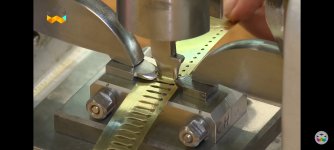Hi J Grainger:
I am neither a watch maker nor a professional diemaker, but I have made a reasonable number of punch dies for tiny prototype parts and I know how to do basic Google searches.
A couple of things about punching thin skinny parts...I've found that the thinner the part, the fussier and more consistent the die clearance has to be to get a good clean part without bends, burrs and tears.
Also, the smaller the die clearance, the more accurately the die needs to be built so the die doesn't self destruct by slamming the edges of the punch into the edges of the die section.
Your maximum die clearance for the thickness of steel you intend to punch will be close to 0.002", so there's not a lot of room for misalignment between punch and die.
If that die clearance is not very consistent, there will be areas that won't shear correctly, and the part won't come out very flat or you'll get areas that didn't shear at all.
Also, the narrower the part is in relation to its thickness, the more demanding it is that you get the die clearance just right all around the periphery of the part.
Incidentally, it also matters that the edges of both punch and die section are perfectly sharp with zero defects like chips or rolled edges...defects like these are fine on punch dies for an ironworker, but not for what you want to make.
You must also have positive relief all around the die land...zero draft is theoretically OK but only if it is perfect everywhere.
If you have half a degree of die relief, there is less of a need to have the angle exactly the same everywhere so long as there is some relief everywhere on the die land.
An area of negative angle or a convex die land is the kiss of death for the die.
So I wire EDM all the punches and dies I build, just to be able to control the geometry easily.
If you don't have access to that tech, you have to know to be careful to get the die land as perfect as you can make it and zero or positive relief is part of that perfection.
The next part is the Google part:
Here's a link to a video and text, showing some of the steps in making watch hands:
One of the things the text points out, is that the hands are friction fit onto the cannon pinion, and this is done by first putting a precision hole into the center of the watch hand and then locally deforming the metal around that hole to form "canons".
As you can imagine, you need to get this part dead nuts accurate or the hands won't be able to be mounted to the cannon pinions.
Also, according to the text, those pinion bores are put in first, before the outline of the hand is blanked.
Speaking of "blanking", there is a process called "fine blanking" for making sheet metal parts that is different in detail from punching, in that the metal is basically extruded through the die section while being supported on both sides rather than being sheared with a punch.
It does not appear, from the few details shown in the video, that this process is being used...the dies look like standard progressive dies to me, but I don't know if fine blanking is needed for certain hand designs, and if they're just not revealing those details to us.
Die clearance for fine blanking is tenths.
So what you hope to do is a pretty tall order.
Now obviously the watchmakers of old did manage to do it without split tenths grinders and Diaform dressers, and wire EDM machines, but my gut tells me it's not going to be an easy road, so expect to be at it for a while before you find success.
The details of what the geometry needs to be I will leave to others with more diemaking and watchmaking experience.
Cheers
Marcus
www.implant-mechanix.com
www.vancouverwireedm.com


